A beautiful person in your garden - the “Golden Queen” tomato: early ripening, bright and so adored by aesthetic summer residents
Russian agronomists have given the world hundreds of tasty and easy-to-care varieties of tomatoes. Just look at the varieties Fire, Golden Stream, and Artist. All these vegetables are famous for their excellent characteristics and have won the hearts of many summer residents.
The Golden Queen occupies a special place among domestic tomato varieties. Tomatoes are famous for their excellent taste; they grow in a greenhouse or in the open air. Let's look further at the features of the Golden Queen and learn the secrets of a successful harvest.
Description of the variety
The tomato is a mid-season tomato; the first harvest appears after 100-110 days. The stem is developed, the leaves are dark green. Tomatoes set and ripen in small clusters. The bush is not limited in growth, the average height is about 1 m.
Distinctive features
The Golden Queen tomato has a medium degree of foliage and powerful bushes. The variety is resistant to crop diseases and adapts well to any climatic conditions. In addition, tomatoes are demanding on the composition of the soil.
After harvesting, tomatoes are stored for a long time and tolerate long-distance transportation well. Often the variety is grown not only for personal consumption, but also for sale.
Characteristics of tomatoes and yield
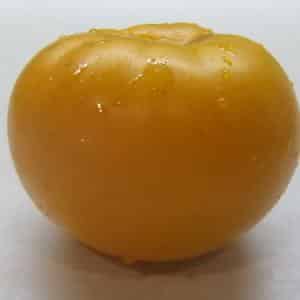 “Golden” vegetables are flat-round and slightly elongated. When ripe they acquire a rich honey-yellow color.
“Golden” vegetables are flat-round and slightly elongated. When ripe they acquire a rich honey-yellow color.
The weight of one tomato is about 300-400 g, in a heifer it can reach 700 g.The stalk has pronounced ribbing.
The pulp is juicy, there are few seeds. The taste is pleasant, sweetish. The aroma is delicious and bright. From 1 sq. m gardeners harvest about 10 kg of tasty vegetables.
How to grow seedlings
Properly prepared seedlings - guarantee of a rich harvest. Take this stage as carefully as possible. Buy seeds for seedlings in a store or order online.
On the packaging, the manufacturer provides a brief description of the variety and recommendations for cultivation.
Seed preparation
Treat the seeds with a solution of potassium permanganate. This will disinfect their surface and destroy dangerous microorganisms. It is assumed that store-bought material has already been pre-treated with special preparations. However, it is better not to risk it and do it again yourself. For convenience, place the seeds in a fabric bag and immerse them in the solution for 20 minutes.
Next, the seeds need to be germinated. Germination is necessary to check the degree of germination of the material and accelerate its development. If during the germination stage you notice that some seeds have not sprouted, get rid of them immediately.
For germination you will need gauze and polyethylene. Wrap the seeds in slightly damp gauze and place in plastic. Make sure that the gauze does not dry out. At the same time, avoid over-watering.
Important! For the fastest germination, it is recommended to use growth stimulants. “Kornevin” is recognized as an effective remedy. Soak the seeds in the solution for 6 hours. “Kornevin” will not only protect the crop from diseases, but will also accelerate the growth of young roots.
Container and soil
Any clean and dry container is suitable for seedlings. Peat pots are the most popular among gardeners.They are environmentally friendly and affordable, and also maintain the required level of moisture. Sold in any specialized store. In addition to peat containers, flower pots or wooden boxes, as well as similar containers, are suitable for seedlings.
The soil is either purchased at the store or prepared independently. Ready-made soil has a number of advantages, the main ones:
- it contains accessible macro- and microelements that plants need;
- the earth contains the necessary microflora;
- distinguished by ease;
- absorbs water well and retains it;
- has an optimal level of acidity.
Among ready-made soils, the mixtures “Shchedra Zemlya”, “Krepysh”, “Bogatyr”, and “Magic Bed” are especially popular. When purchasing, trust only trusted manufacturers with a good reputation. It would be a good idea to consult with your gardener friends and find out what mixture they use for seedlings.
Sowing
Prepare the seedlings 50-60 days before planting on the site. Place drainage at the bottom of the container, add soil and water with warm, settled water. When the water is absorbed, make holes 1-2 cm deep. Sow seeds in them and sprinkle soil on top.
The optimal distance between seeds is about 3 cm. If the soil is dry, spray it with a spray bottle. Cover the containers with a lid and place in a warm, lit place.
Growing and care
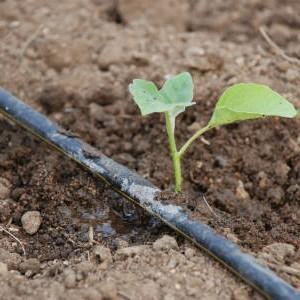 The temperature should be no lower than 20-23 degrees. After the first shoots appear, the lid must be removed.
The temperature should be no lower than 20-23 degrees. After the first shoots appear, the lid must be removed.
The seedlings should stand in a bright place, otherwise arrange additional lighting using lamps. The first watering is 10 days after planting the seeds. Only settled warm water is suitable for irrigation.
As soon as the first leaves appear, feed the seedlings. Liquid bird droppings or the drug “Fitosporin” are suitable for this. This protects the plant from possible diseases and strengthens the immune system.
In the future, it is recommended to feed tomatoes every 10 days.
How to grow tomatoes
Properly grown seedlings acquire a rich green color. It is transplanted into the garden after the appearance of 6-7 leaves and the first flower cluster.
Landing
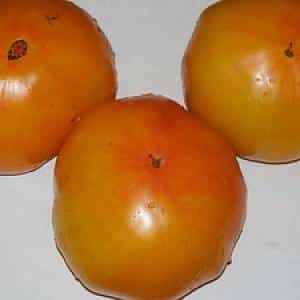 First, prepare the soil in the garden or vegetable garden. The first stage begins in the fall, when gardeners remove all garbage and plant debris from the site.
First, prepare the soil in the garden or vegetable garden. The first stage begins in the fall, when gardeners remove all garbage and plant debris from the site.
In the spring the beds are dug up – this saturates the soil with oxygen and makes it more airy. It is necessary to disinfect the soil, for example, with hydrogen peroxide or boiling water. Also create a top layer of sawdust or sand. These elements additionally perfectly loosen the soil.
Important! For 1 sq. m plant no more than 3 plants. Dense planting reduces yield, so the optimal distance between bushes should be at least 50 cm. Planting is completed by watering the plants.
Care
The Golden Queen variety is formed into 1 or 2 stems. Water the bushes after 12 days after disembarkation. Watering should be targeted, preferably so that the water gets directly under the root.
Excessive humidity creates dangerous fungi and diseases. Later the plant watered every 5-6 days. It is best to do this in the early morning or evening. If the summer is hot and rainy, the amount of watering is reduced.
Tomatoes form stepsons. In other words, these are additional shoots that need to be removed every 5-8 days. Grooming is a must when caring for the Golden Queen. It is better to handle plants while wearing gloves.Sometimes garden shears are used.
Don’t forget to loosen the soil and remove weeds. If this is not done, the favorable environment for the development of tomatoes will be disrupted, which will affect the quantity and quality of the harvest.
Be sure to apply mineral and organic fertilizers. The Golden Queen is fed from the moment the first ovaries form. Wood ash serves as an excellent fertilizer. It is easy to obtain and has an effective effect on the health of the bushes. In addition to ash, gardeners actively use liquid mullein, urea, ammonium nitrate, and plant tea fertilizers as fertilizers.
Features of cultivation and possible difficulties
It is important that by the time of planting vegetables the soil is as saturated with useful elements as possible. To do this, in early spring, add a mixture of compost, sand and garden soil to the soil. Tamp down thoroughly and water. This soil preparation is especially relevant for greenhouses and greenhouses.
In the process of growing varieties, gardeners are faced with the problem of a lack of nitrogen-containing fertilizers. White and yellow spots appear on the leaves, and the bushes slowly dry out. To prevent this, alternate mineral and organic fertilizers. Apply them at intervals of 10-15 days until harvest. Fertilizing not only develops the plant, but also protects it from diseases.
Diseases and pests
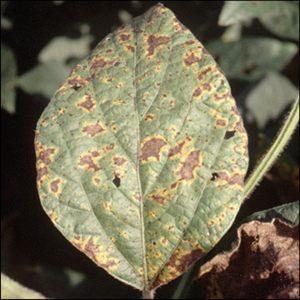 The most common “tomato” disease is late blight. This is a fungus that can destroy half or most of the crop in a short time. It looks like a white coating and brown spots on the leaves.
The most common “tomato” disease is late blight. This is a fungus that can destroy half or most of the crop in a short time. It looks like a white coating and brown spots on the leaves.
Get infected late blight easily through the ground or nearby plant beds. The fungus actively develops in heat and rain. For prevention, use spraying with garlic solution.
Another dangerous fungus causes septoria. Appears as white small spots with a brown rim. Septoria blight is popularly called “white spot”. To protect the crop from it, promptly burn the remains of last year’s plants, since they become the main source of spotting infection.
From pests Tomatoes are loved by Colorado potato beetles, whiteflies, wireworms and aphids. For preventive purposes, place dry eggshells on the beds. Also spray regularly. For example, a whey solution is suitable for combating aphids and whiteflies; onion peels are used for Colorado beetles. Wireworms are afraid of a solution based on tobacco leaves.
The nuances of growing in open ground and in a greenhouse
When growing Golden Queen in a greenhouse, plant legumes between the beds. They saturate the soil with oxygen and nitrogen and heal the root system of tomatoes. Plant basil around the perimeter of the greenhouse. It has been proven that it makes tomatoes taste brighter and richer.
In open ground, use a drip irrigation system. Water immediately flows to the roots of the plant, which absorb it gradually. In addition, it is safe to feed and fertilize tomatoes using the drip method. The system saves not only water, but also the time and effort of gardeners.
Harvesting and application
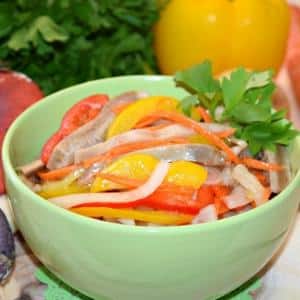 Golden Queen is excellent for children's and dietary nutrition. Vegetables contain a large amount of vitamins and beneficial elements.
Golden Queen is excellent for children's and dietary nutrition. Vegetables contain a large amount of vitamins and beneficial elements.
The components have a beneficial effect on human immunity, being a natural antioxidant, they improve digestion.
Tomatoes are used to make snacks, salads and side dishes. The taste of the Golden Queen is filled with fruity notes that perfectly complement fish dishes.The variety also goes well with other vegetables, especially cucumbers and bell peppers.
It is recommended to collect tomatoes gradually, as they ripen. The yield of the variety is friendly. Golden Queen stores well, especially if you place the vegetables in a cool place.
Advantages and disadvantages of the variety
The strengths of the variety include its wonderful taste and beautiful appearance. In addition, the vegetable is universal in use, has immunity to disease and has a long shelf life.
Among the shortcomings, gardeners note only the need to form a bush. Otherwise, the Golden Queen meets all the requirements of an excellent variety.
Farmer reviews
This is what summer residents say about the Golden Queen variety.
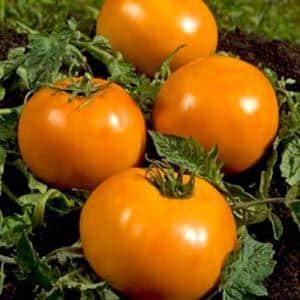
Alexandra, Obninsk: “Tomatoes are truly “royal.” I like their bright color and equally bright taste. They are good both fresh and as an ingredient in some dishes. I especially often add them to pizza or summer salads.”
Maria, Saratov region: “The Golden Queen, in my opinion, is one of the best varieties. “That year I planted it for the first time, the tomatoes started growing quickly, there were no problems with growing.”
Elvira, Moscow: “In general, the variety is not bad, but it requires too much attention. It forms many stepsons, which I removed every week. In this it loses to other tomatoes, which are less demanding in care.”
Conclusion
Golden Queen or Golden Queen - you can call these tomatoes whatever you like. The main feature is that they have amazing taste. The variety is planted in greenhouses or in the open air.
Care involves watering, fertilizing, forming bushes and fertilizing. The yield of the variety is excellent. An ideal variety for lovers of yellow vegetables.